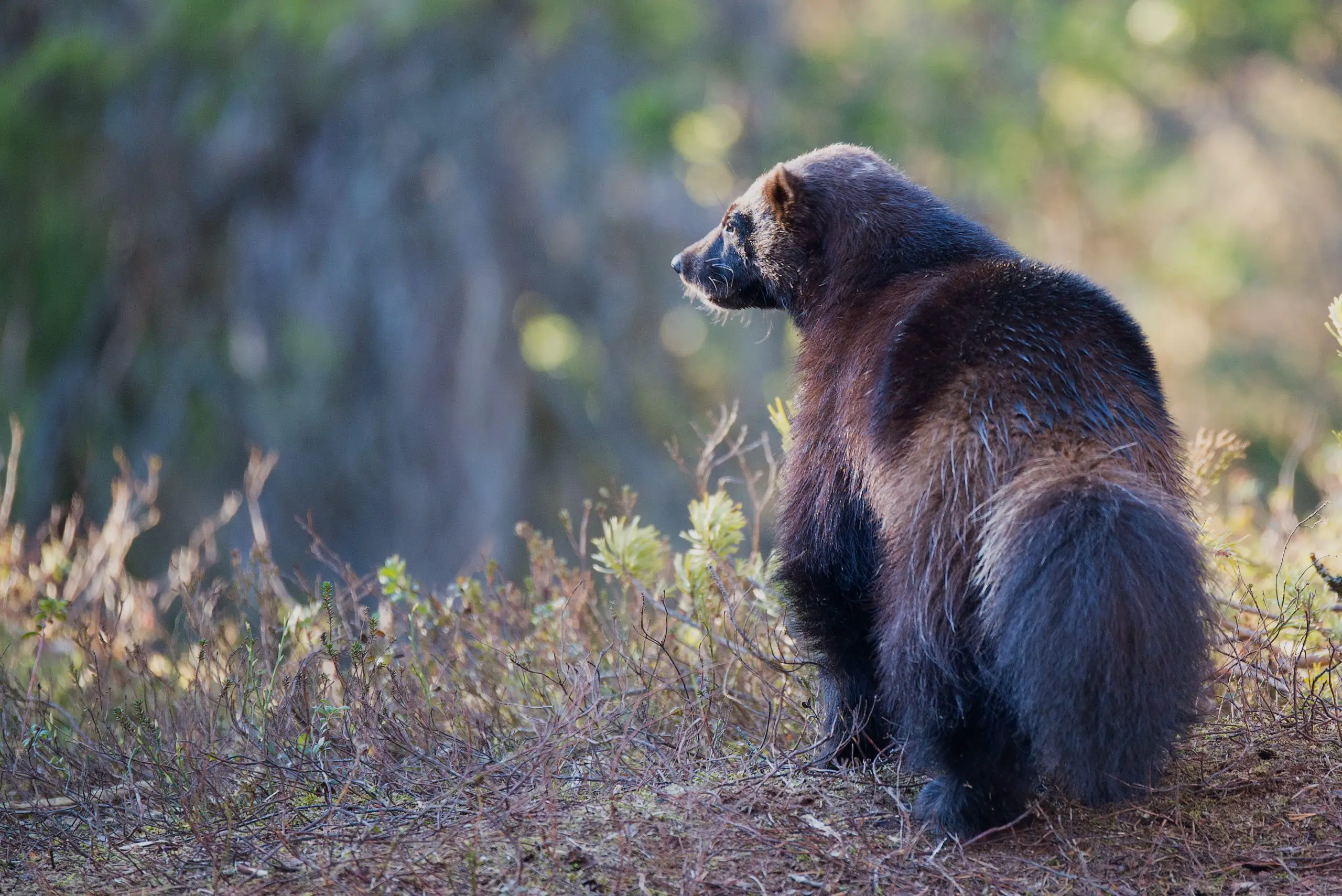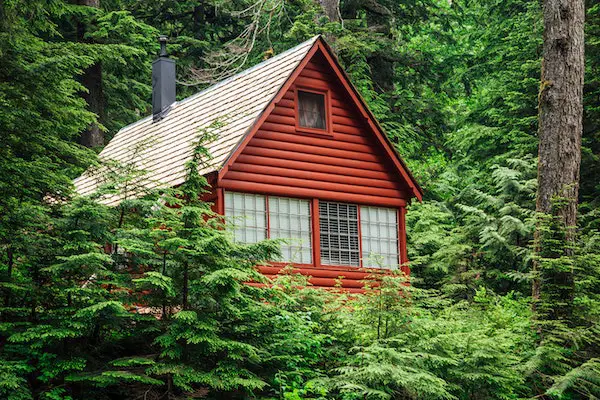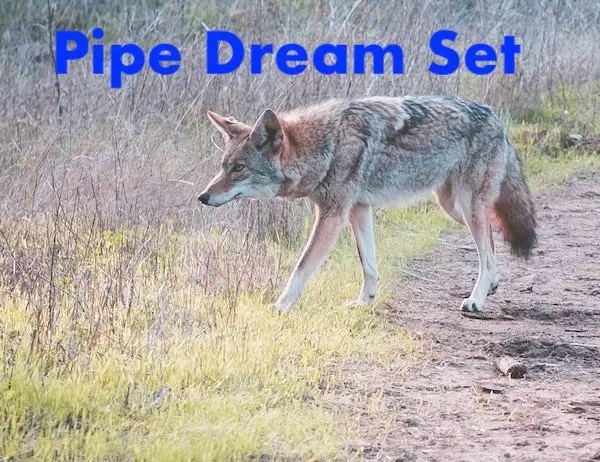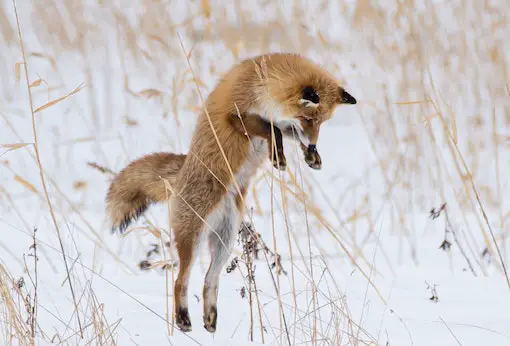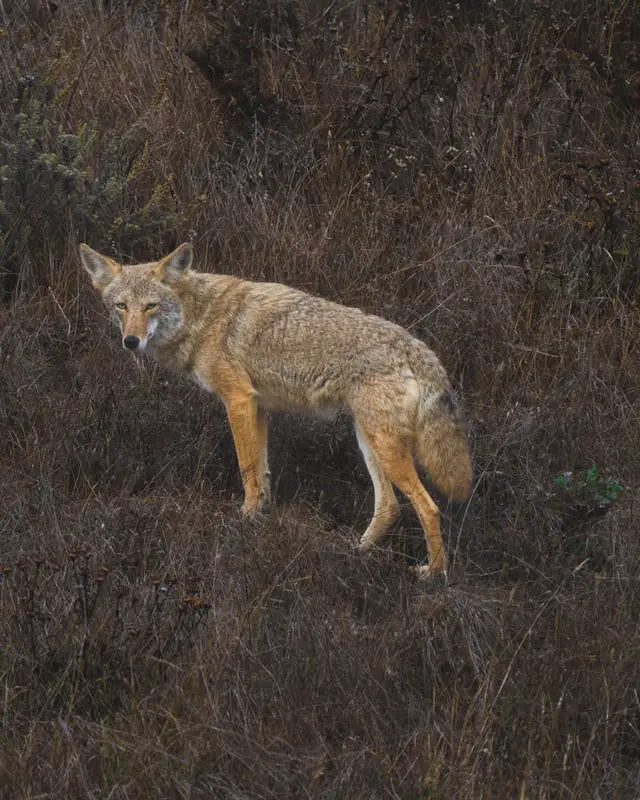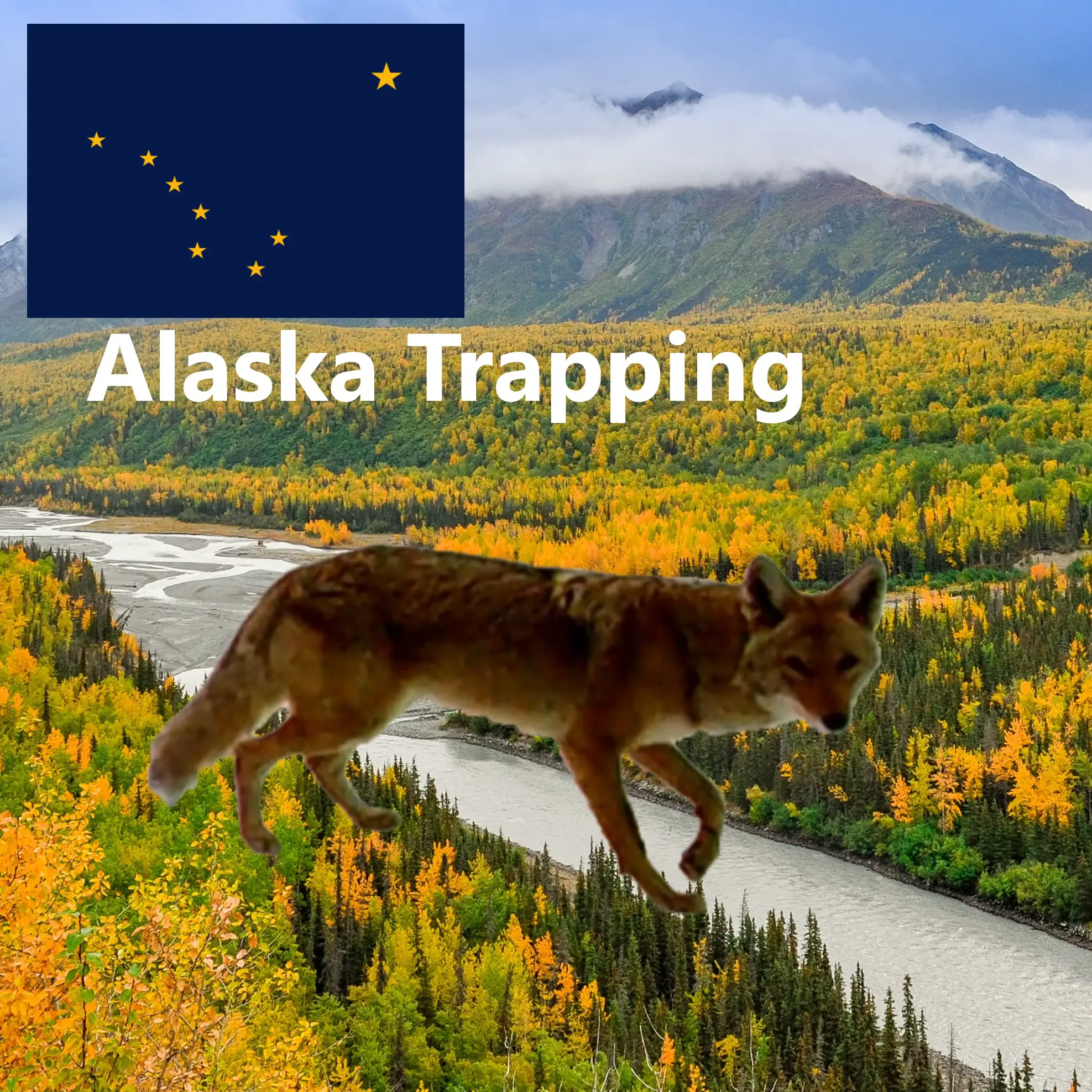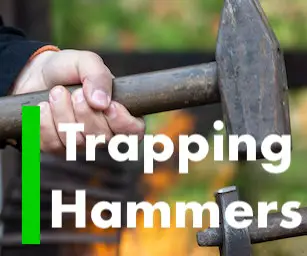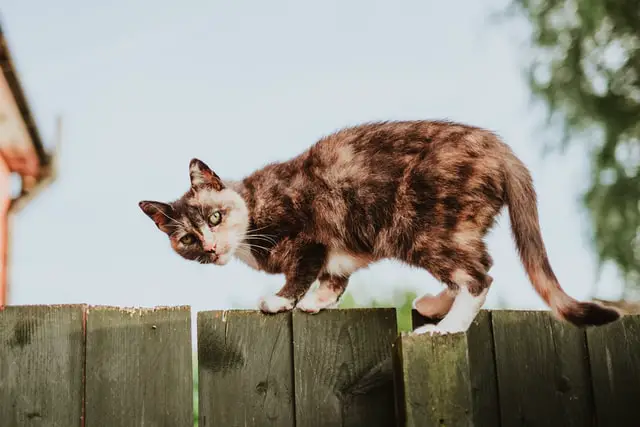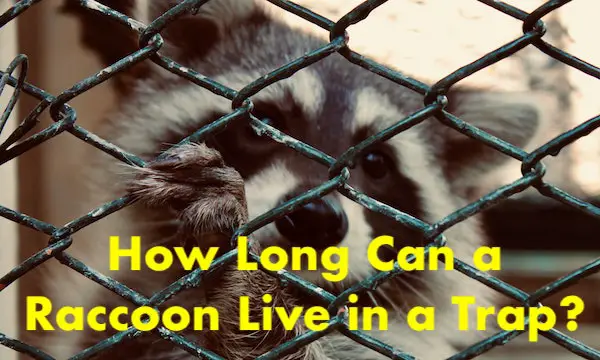Dirt Hole Set for Coyotes
Setting a dirt hole set for a coyote is super simple and can work very well to catch coyotes.
The idea is to make the coyote think that another animal has buried food in a dirt hole. Then, with your foothold trap buried in front of the hole, you will be able to attract and hopefully catch the coyote as it investigates the dirt hole set.
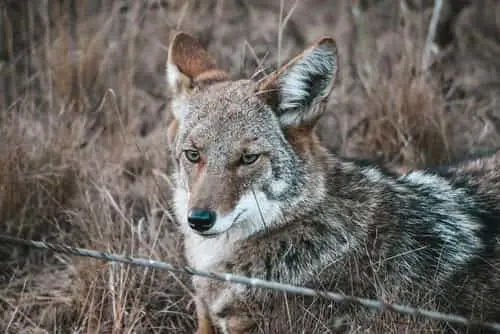
Table of contents
- How to make a dirt hole set
- Picking a spot for the trap
- Scent Control
- Trap pan cover
- Bedding a trap
- Making a dirt hole
- Dirt hole trap for a coyote
- How to bait coyotes
- Dirt hole set supplies
How to Make a Dirt Hole Set
Here is an awesome video we found on how to make a dirt hole set. It explains many of the key points of making a dirt hole set that will catch coyotes.
Picking a Location For The Trap
The first thing you want to do is pick the right location for the dirt hole trap. There are a few things to consider when you pick this location.
When setting traps, I do best when I am setting on sign or I am in a location that I know coyotes are traveling. The best way to tell coyotes are in an area is scat and tracks.
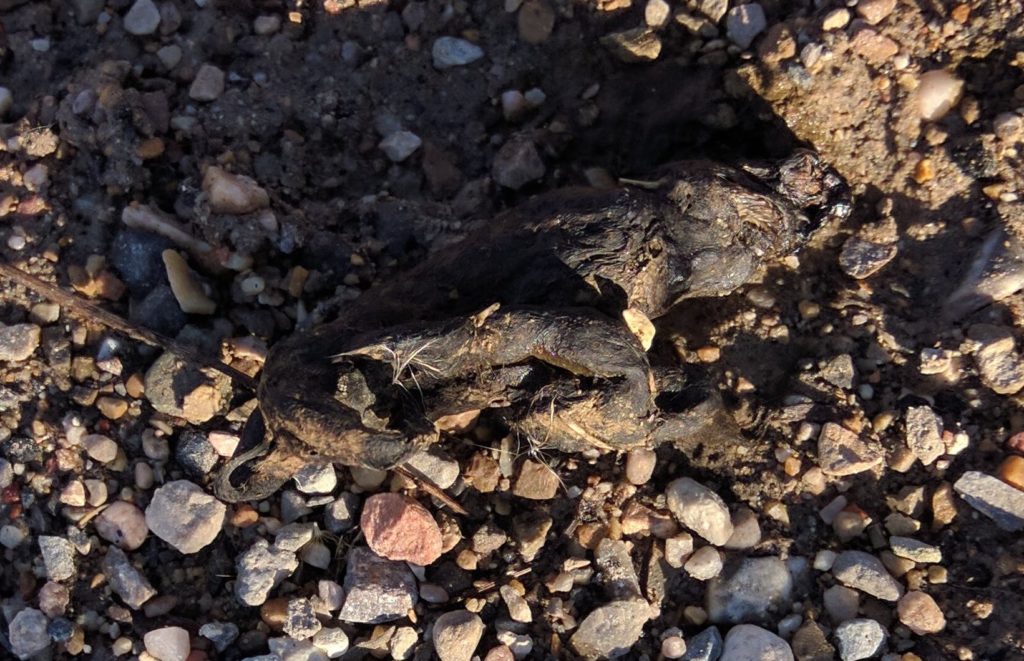
Coyote scat looks like dog poop but it is full of small broken up bones and hair. It is also tapered at the ends.
Coyote tracks look can look like dog tracks but their claws point towards the middle of the foot. The toes on a coyote track are closer together than a dog’s toes and the middle two toes are farther away from the back pad than the two outer tows.
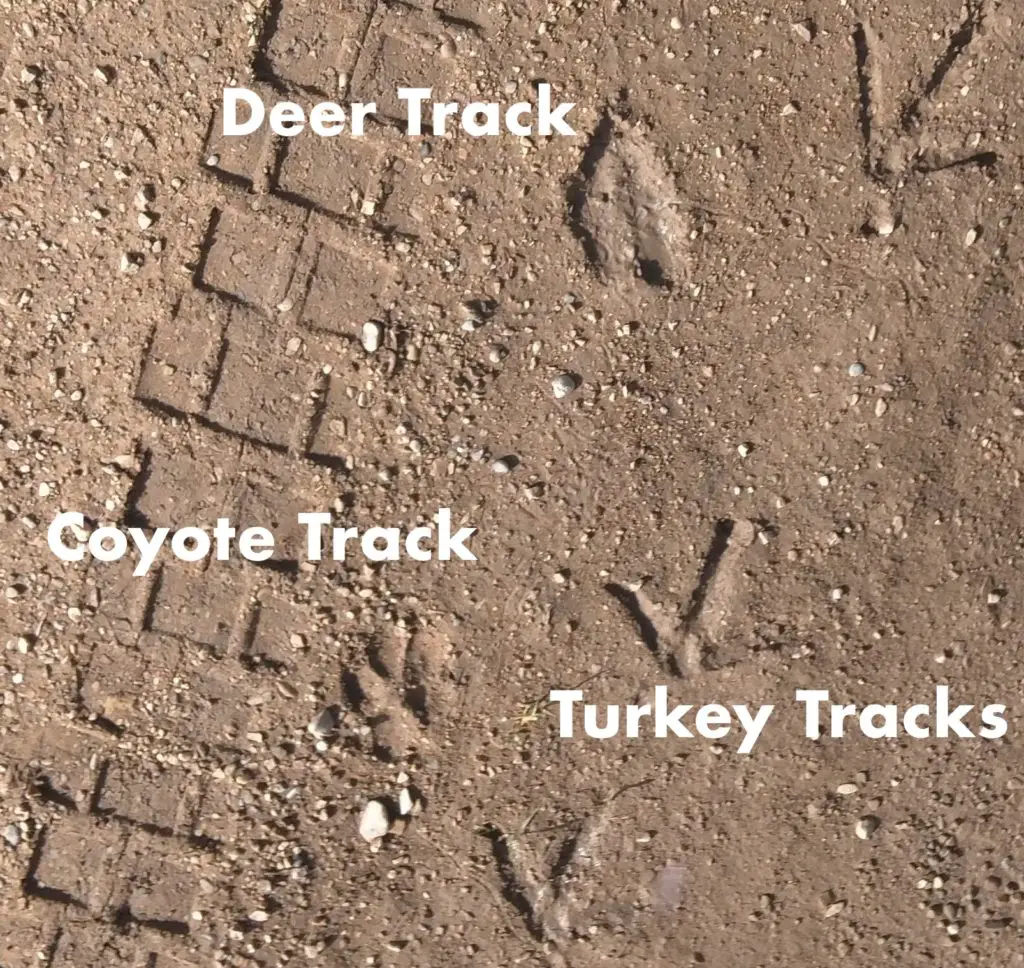
When you have found a location where coyotes are passing the next is to pick a location for your trap.
The location I would pick for the trap would be close to a trail, road, or fence line where the coyotes appear to be passing very close.
Then on the side of the trail or road or fence look for something that will keep the coyote from sneaking in the back and digging for the food in the dirt hole and not stepping on the trap. This can be a log, steep bank of dirt, or a rock or bolder. If there is not a backing close by you can build your own out of what you have around you.
Minimizing Your Sent At a Dirt Hole Set
Coyotes have a very strong science of smell. They can smell if you have touched the trap, so there are a few things you need to do to prepare your trap.
The first thing is you need to boil your trap in water to remove any human or other odors from the trap that only a coyote can smell.

The other thing you need to do to control leaving a lot of scent on your trap is to use gloves when setting and burying the trap. Touching the trap at all with your bare hands can leave your odor on the trap and a coyote could dig it up.
You may also want to die and wax your traps. Click here to learn more about that.
Trap Pan Cover
Your pan cover is a very important part of setting a trap. This is anything that keeps the dirt out from under your trap.
There are several kinds of pan covers, but you do need to use one of them. Some of them are wax paper (goes over the pan), insulation (goes under the pan), poly-cotton (goes under the pan), or wire mesh(goes on top of the pan).

The pan covers will keep the dirt out from under your trap pan or trigger and keep it working better for a longer period of time. This will reduce the need to dig up the trap to keep it working.
Bedding a trap
Bedding a Coyote Trap
Digging a dirt hole and a hole for the trap you want to make it look like some animal was digging there but not dig up a large area.
I like to dig the trap bed first using your trapping hammer. You will want your dirt hole to be a little back from the backing leaving four or five inches for the dirt hole to fit between the backing and the edge of your hole. You want your trap hole to be slightly larger than the foothold trap you are using.
Then anchor your trap to the bottom of the hole with steaks or earth anchors.

You can also use a drag to hook to your trap. A drag is a large anchor that can make trap setting faster. The anchor hooks on bushes and shrubs as the coyote runs away. If you are using a drag remember to use sufficient chain (at least 4 to 5 feet) so the drag gets tangled up quickly in the brush.
You don’t have to drive steaks if you use the drag method and this can save you time. If you use this drag you can place your tap in the hole and bury the first few feet of chain closest to the trap.
Now you want the dirt at the bottom of the trap hole to be a little loose. You want to place your trap in the hole with the dog or the piece of metal holding the trap open at about the one or two a clock position.
Shift and bed your trap in the loose dirt in the bottom of the hole. Bedding is the process of making it so your trap does not shift in the hole when you press on the outer edges of the jaws of the trap. If a coyote feels this movement or shifting or your buried trap then it will dig up your trap and not get caught in it.
You may need to put more dirt in the bottom of the hole to bury the chain or if the trap is wobbling. Also packing dirt around the open jaws can make the trap stop moving. This can take a bit of practice to get right.
Now using a trapping sifter shake dirt over your trap until the trap is completely buried. The pan or trigger in the middle of the trap usually gets more dirt on it in this process, I usually use a stick and flatten it out. I use a stick because I have caught my finger in the trap and it hurts!
Making a Dirt Hole Set
Now you can dig a dirt hole. The placement of the dirt hole and the order in which you dig the dirt hole and the trap bead are not important as long as you follow the trap and dirt hole placement steps.
Dirt Hole Set Diagram
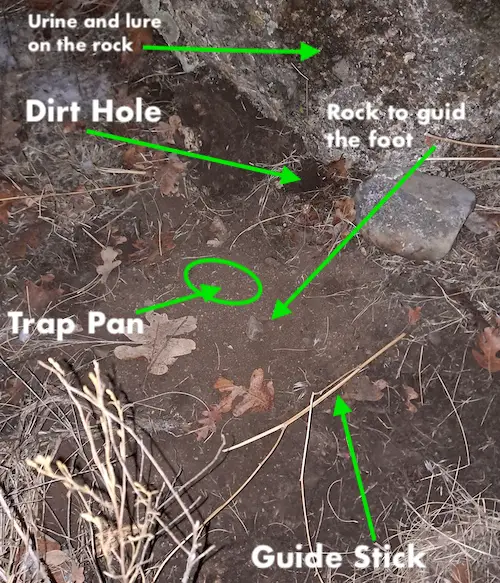
Trap Placement
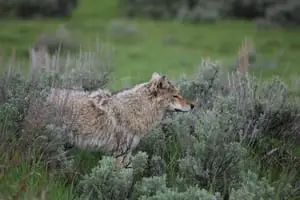
This is a very important step is where do you put the dirt hole in comparison to the trap and trap pan? Most trappers like a two-inch offset for their trap to the right or the left of the center of the dirt hole. They are trying to place it where the coyote will step when he starts digging in the dirt hole.
I would recommend that you have your pan offset to the right or the left two inches. The jaw of the trap about an inch back from the hole forward and back so that the trap stays covered with dirt.
Using An Auger And Drill To Make The Dirt Holes Faster
When digging a dirt hole you want it to be at least five to six inches deep. This forces the coyote to dig for the bait. The longer he digs at the hole the more likely he is to step on your trap.
To make a dirt hole it may be useful to use a drill and an auger about one to three inches in diameter. This makes the dirt hole harder to dig up and allows you to get the set in faster.
I would recommend a battery-powered drill with a side handle for better digging power.
If the ground is too rocky or hard and you can’t get a dirt hole deep enough, then there are some alternatives.
One is to dig a small trench and then put a large rock over the trench to make it look like a hole is going under the rock. You can also do this with a log or straw pile.
Using A Dirt Hole Punch
Another way to make a dirt hole is with a dirt hole punch. This is a pipe that is hammered into the ground and then turned to dig out the hole. Then the dirt comes nicely out of it when you hit it with a trapping hammer.
The final way to get a dirt hole into the ground is with a piece of rebar or a steak that you drive into the ground and then rotate to make a cone shape dirt hole set.
Dirt hole trap for a coyote
What Is The Best Trap For A Dirt Hole Set?
The trap you should use at a dirt hole set should be a coil spring jaw trap or leg hold trap. These come in several sizes but the best for coyotes are number two and number three sized traps.
The number of the trap are the gages by the jaw size. These sizes are calculated so that the trap is bigger and stronger as the number gets higher.
Some of the best traps for coyotes are the MB 450 and the MB 550 made by Minnesota Brand trappers. Check out are article about using the MB 450 for coyotes.
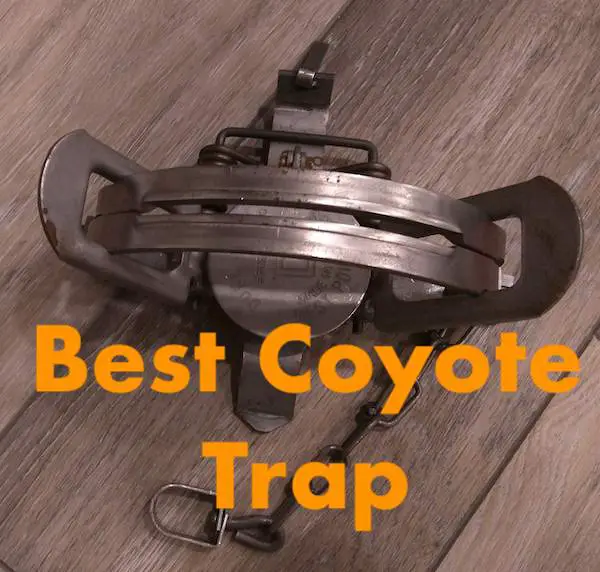
Related Article: MB 450 For Coyotes
How To Bait A Dirt Hole Set
The best bait for catching coyotes is the one that keeps them there the longest. A lot of trappers use a combination of three different types of baits or lures to get the coyote to stay as long as possible.
The first thing you need is bait. This is usually a meat-based food that a coyote would like. It may be chunks of meat if you have it or commercially sold bait is usually a paste.
When putting bait in a dirt hole set you want to make sure that you get it in the dirt hole and not on your trap.
One of the best ways I have seen is to put paste bait in sheep’s wool and then it holds it better out of the dirt so the coyote can smell it better. The sheep’s wool is also a good visual attractant if they can see it at the bottom of your dirt hole.
If you put chunks of meat at the bottom of the hole then you may not need sheep’s wool. I have trapped with and without sheep’s wool and it can be helpful.
Coyote lure for trapping
The next thing that is very important is the gland lure or some other kind of lure. This is a very strong smelling lure that is made from the glands of different animals. These animals include fox, coyote, and skunk.
These glands or other fermented baits are very attractive to coyotes and can be used to attract them when they don’t come close enough to smell the bait.
One I have used had some skunk in it and with my poor human nose, I could smell them from several feet away. Try not to get this stuff on your hand it is bad and sometimes won’t wash out for a few days.
When applying lure to your dirt hole set I would get a small stick and dip it in the lure and set the stick between your backing and the dirt hole. This will cause the coyote the step in the area of your trap to smell the lure.
Coyote, fox, or bobcat urine
I have not used a lot of urine on my traps but it helps the coyote think another animal has been there and it can help them be calmer around the set because it smells like another animal.
Urine is definitely an awesome attractant and has a very strong and potent smell. You can use urine from any animal almost and still get some results with it. Some of the best urines are from coyotes, foxes, and bobcats.
These three are always competing for food and space so it will be a common smell and attractive smell for a coyote.
Here are some of the urines that will be helpful for making your dirt hole set.
Coyote Scat
Adding coyote scat to the set may help the coyote feel more comfortable. It makes them think another coyote has been past and marked the location as his own. Coyotes will steal the bait from the other coyote.
Conclusion
At this point, you are done with preparing a dirt hole set. Remember to check the local laws for the space of time between checking your traps that are legal to wait. There are several other laws that we don’t discuss in this article but that you must follow in your state guides.
Hope you learned how to catch a coyote in a dirt hole set. Happy trapping!
- This set can work for other furbearers such as fox trapping, bobcat trapping, and badger trapping.
- Check out all the other coyote trapping sets we recommend in our coyote sets article.
Dirt hole set supplies
Starter kit with everything you need to get started trapping coyotes and making dirt hole sets.
Trapping hammer for driving stakes and digging trap beds
Traps for catching the coyote
Earth anchors to hook on your traps.
Chain Link to hook anchors to trap.
Sift for sifting dirt over the trap.
Pan cover for keeping your tap functioning longer.
Auger and drill or dirt hole punch to make the dirt hole.
Urine, Lure, Bait to attract the coyote.
Trapping bucket, pack basket, or trapping bag to put everything in.
Catch-pole for removing non-target animals.
.22 Long Rifle or pistol for shooting target animals.
Trapping Sets
Trapping By State
- Alabama Trapping
- Alaska Trapping
- Arizona Trapping
- Arkansas Trapping
- California
- Colorado
- Connecticut
- Delaware
- Florida
- Georgia
- Hawaii
- Idaho
- Illinois
- Indiana
- Iowa
- Kansas
- Kentucky
- Louisiana
- Maine
- Maryland
- Massachusetts
- Michigan
- Minnesota
- Mississippi
- Missouri
- Montana
- Nebraska
- Nevada
- New Hampshire
- New Jersey
- New Mexico
- New York
- North Carolina
- North Dakota
- Ohio
- Oklahoma
- Oregon
- Pennsylvania
- Rhode Island
- South Carolina
- South Dakota
- Tennessee
- Texas
- Utah Trapping
- Vermont
- Virginia
- Washington
- West Virginia Trapping
- Wisconsin
- Wyoming Trapping



